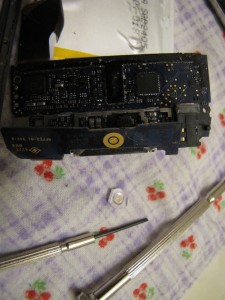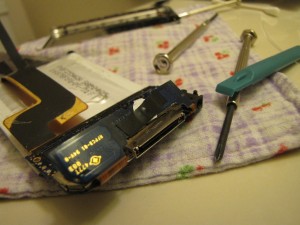1 working home button in my pocket
My iPod touch’s home button was growing gradually unreliable, and finally stopped letting me switch between apps right before this week’s iPod press event. I was hoping Apple would finally announce a new iPod touch that could serve as an iPhone without the phone, with a camera and mic and compass and GPS. Instead they announced the opposite.
This was the second time the iPod touch’s home button had failed me. The first one failed under warranty, but between two bad hardware experiences (actually three, long story…), a lack of compelling new features, the lack of independently published applications and my own lack of income, buying an expensive replacement seemed like a bad idea.
Instead I spent $3.98 to have OWC ship me some nylon iPod case opener tools. Once inside I found a lot of lint, dozens of tiny screws and chips and connectors, and underneath it all:

My iPod’s home button!
I used some rubbing alcohol on a q-tip to clean it and its target off a bit, then used a very short slice of electrical tape to hold the little clicker sticker back in place.

Take a look at this iPod Touch repair guide for a better walkthrough of the internals. Because of the way the lower assembly is glued down, the screen does need to be taken off to safely pry the button board from its sticky bondage. There was dust under the glass anyway, so it was nice to get a PEC*PAD in there for some cleanup.
In addition to the case opener (good for prying PCBs from their glue as well) and a very tiny Phillips screwdriver, I found a brownie cutter useful. Its large surface area helped me pry up the battery pack without the acute pressure of a flathead’s blade; a metal spatula or wide paint scraper could work as well.
After reassembling most of the device, I was relieved and more than a bit surprised to see it spring back to life. Despite the second-rate button, some impressive engineering went into this device. It is incredibly small, yet was able to survive an hour of my (very careful!) amateur hamfisting. I can now return to my Home screen at will; all other systems are still go, too!